Adapting the Digital Servuction Model to Central Banks: Case Study: European Central Bank
Abstract
:1. Introduction
2. The Quality of Public Sector Services Now and Then
2.1. Development of Central Bank Communication
2.2. Public Service Marketing Communication within Central Banks
2.2.1. The SERVQUAL Scale
2.2.2. E-SERVQUAL
3. Results and Discussion
4. Materials and Methods
5. Conclusions, Limitations, and Research Perspectives
Author Contributions
Funding
Institutional Review Board Statement
Informed Consent Statement
Data Availability Statement
Conflicts of Interest
References
- Andronie, Mihai, George Lăzăroiu, Roxana Ștefănescu, Luminița Ionescu, and Mădălina Cocoșatu. 2021. Neuromanagement decision-making and cognitive algorithmic processes in the technological adoption of mobile commerce apps. Oeconomia Copernicana 12: 1033–62. [Google Scholar] [CrossRef]
- Angur, Madhukar G., Rajan Nataraajan, and John S. Jahera Jr. 1999. Service quality in the banking industry: An assessment in a developing economy. International Journal of Bank Marketing 17: 116–25. [Google Scholar] [CrossRef]
- Avkiran, Necmi Kemal. 1994. Developing an Instrument to Measure Customer Service Quality in Branch Banking. International Journal of Bank Marketing 12: 10–18. [Google Scholar] [CrossRef]
- Bank of England. 2022. Available online: https://www.bankofengland.co.uk/ (accessed on 18 August 2023).
- Barontini, Christian, and Henry Holden. 2019. Proceeding with Caution—A Survey on Central Bank Digital Currencies. BIS Papers 101. Available online: https://www.bis.org/publ/bppdf/bispap101.pdf (accessed on 19 August 2023).
- Belke, Ansgar. 2017. Central Bank Communication: Managing Expectations through the Monetary Dialogue. ROME Working Papers 201704. Available online: https://ideas.repec.org/p/rmn/wpaper/201704.html (accessed on 14 November 2022).
- Belke, Ansgar, and Thorsten Polleit. 2011. How much fiscal backing must the ECB have? The euro area is not (yet) the Philippines. Économie Internationale 124: 5–30. [Google Scholar] [CrossRef]
- Bennani, Hamza. 2020. Central bank communication in the media and investor sentiment. Journal of Economic Behavior and Organization 176: 431–44. [Google Scholar] [CrossRef]
- Bernardelli, Michal, Zbigniew Korzeb, and Pawel Niedziółka. 2021. The banking sector as the absorber of the COVID-19 crisis’ economic consequences: Perception of WSE investors. Oeconomia Copernicana 12: 335–74. [Google Scholar] [CrossRef]
- Bholat, David, James Brookes, Chris Cai, Katy Grundy, and Jakob Lund. 2017. Sending Firm Messages: Text Mining Letters from PRA Supervisors to Banks and Building Societies They Regulate. Bank of England Working Papers. Available online: https://ideas.repec.org/p/boe/boeewp/0688.html (accessed on 14 November 2022).
- Bholat, David, Nida Broughton, Alice Parker, Janna Ter Meer, and Eryk Walczak. 2019. Enhancing Central Bank Communications Using Simple and Relatable Information. Journal of Monetary Economics 108: 1–15. [Google Scholar] [CrossRef]
- Bicchal, Motilal. 2022. Central bank credibility and its effect on stabilization. Economic Analysis and Policy 76: 73–94. [Google Scholar] [CrossRef]
- Blinder, Alan S. 2009. Talking about monetary policy: The virtues (and vice?) of central bank communication. SSRN Electronic Journal, 2–25. [Google Scholar] [CrossRef]
- Blinder, Alan S., Michael Ehrmann, Marcel Fratzscher, Jakob De Haan, and David-Jan Jansen. 2008. Central Bank Communication and Monetary Policy: A Survey of Theory and Evidence. Journal of Economic Literature, American Economic Association 46: 910–45. [Google Scholar] [CrossRef]
- Blut, Markus, Nivriti Chowdhry, Vikas Mittal, and Christian Brock. 2015. E-service quality: A meta-analytic review. Journal of Retailing 91: 679–700. [Google Scholar] [CrossRef]
- Bui Thi Thu, Ha, Quyen Bui Tu, Thanh Nguyen Thi Phuong, Quang Cao Huu, Thuy Phung Van, and Ha Nguyen Thanh. 2022. Does the SERVPERF instrument have reliability and validity in an academic setting: The results from Vietnam. Journal of Health and Development Studies 6: 27–37. [Google Scholar] [CrossRef]
- Bulir, Ales, and Katerina Smidkova. 2008. Striving to Be ‘Clearly Open’ and ‘Crystal Clear’: Monetary Policy Communication of the CNB. IMF Working Papers 084. [Google Scholar] [CrossRef]
- Buttle, Francis A. 1996. SERVQUAL: Review, critique, research agenda. European Journal of Marketing 30: 8–32. [Google Scholar] [CrossRef]
- Calvo, Marcos, Fernando García, Lluis-F. Hurtado, Santiago Jiménez, and Emilio Sanchis. 2013. Exploiting multiple hypotheses for Multilingual Spoken Language Understanding. In Proceedings of the Seventeenth Conference on Computational Natural Language Learning. Sofia: Association for Computational Linguistics, pp. 193–201. [Google Scholar]
- Carrillat, François A., Fernando Jaramillo, and Jay P. Mulki. 2007. The validity of the SERVQUAL and SERVPERF scales: A meta-analytic view of 17 years of research across five continents. International Journal of Service Industry Management 18: 472–90. [Google Scholar] [CrossRef]
- Carvalho, Cláudia, Carlos Brito, and José Sarsfield Cabral. 2010. Towards a conceptual model for assessing the quality of public services. International Review on Public and Nonprofit Marketing 7: 69–86. [Google Scholar] [CrossRef]
- Célérier, Laure, Eve Chiapello, and Anne Jeny. 2022. The Intangible Assetization of the State. The Case of a French Reform (2007–2020). SSRN Electronic Journal, 2–38. [Google Scholar] [CrossRef]
- Chuen, David, Li Yan, and Yu Wang. 2021. A global perspective on central bank digital currency. China Economic Journal 14: 1–16. [Google Scholar] [CrossRef]
- Cook, David P., Chon Huat Goh, and Chen H. Chung. 1999. Service typologies: A state-of-the-art survey. Production and Operations Management 8: 318–38. [Google Scholar] [CrossRef]
- Cristobal, Eduard, Carlos Flavian, and Guinaliu Miguel. 2007. Perceived e-service quality: Measurement validity and effects on consumer satisfaction and web site loyalty. Managing Service Quality 17: 317–40. [Google Scholar] [CrossRef]
- Cronin, Joseph J., Jr., and Steven A. Taylor. 1992. Measuring Service Quality—A Reexamination and Extension. The Journal of Marketing 56: 55–68. [Google Scholar] [CrossRef]
- Cross, James P., and Derek Greene. 2020. Talk Is Not Cheap: Policy Agendas, Information Processing, and the Unusually Proportional Nature of European Central Bank Communications Policy Responses. Governance 33: 425–44. [Google Scholar] [CrossRef]
- Dabholkar, Pratibha A. 1996. Consumer evaluations of new technology-based self-service options: An investigation of alternative modes of service quality. International Journal of Research in Marketing 13: 29–51. [Google Scholar] [CrossRef]
- Dabija, Dan-Cristian, Raluca Băbuţ, and Ciprian-Marcel Pop. 2013. A Customer-Oriented Approach to Satisfaction with Public Service Providers. Empirical Findings from a Market Undergoing Liberalization. Transylvanian Review of Administrative Sciences 9: 26–49. [Google Scholar]
- Ekkehard, Ernst, and Rossana Merola. 2018. Central Bank Communication: A Quantitative Assessment. International Labour Office, 33. Research Department Working Paper n°33: Central Bank Communication: A Quantitative Assessment. Available online: https://ideas.repec.org/p/ilo/ilowps/995008793102676.html (accessed on 18 August 2023).
- European Central Bank. 2022. Available online: https://www.ecb.europa.eu/home/html/index.en.html (accessed on 18 August 2023).
- Fassnacht, Martin, and Ibrahim Koese. 2006. Quality of electronic services: Conceptualizing and testing a hierarchical model. Journal of Service Research 9: 19–31. [Google Scholar] [CrossRef]
- Federal Reserve. 2022. Federal Reserve Board—About the Fed. Available online: https://www.federalreserve.gov/aboutthefed.htm (accessed on 18 August 2023).
- Ferrara, Federico Maria, and Siria Angino. 2022. Does Clarity Make Central Banks More Engaging? Lessons from ECB Communications. European Journal of Political Economy 74: 102146. [Google Scholar] [CrossRef]
- Field, Joy M., Gregory R. Heim, and Kingshuk K. Sinha. 2004. Managing quality in the e-service system: Development an application of a process model. Production and Operations Management 13: 291–306. [Google Scholar] [CrossRef]
- Fitzsimmons, James A., and Mona J. Fitzsimmons. 2006. Service Management: Operations, Strategy, and Information Technology. New York: Irwin McGraw-Hill. [Google Scholar]
- Fountain, Jane E. 2002. Paradoxes of Public Sector Customer Service. Jane E. Fountain 14: 55–73. [Google Scholar] [CrossRef]
- Fragkos, Georgios, Cyrus Minwalla, Jim Plusquellic, and Eirini Eleni Tsiropoulou. 2020. Artificially Intelligent Electronic Money. IEEE Consumer Electronics Magazine 10: 81–89. [Google Scholar] [CrossRef]
- Gajanova, Lubica, Margareta Nadanyiova, and George Lazaroiu. 2020. Specifics in brand value sources of customers in the banking industry from the psychographic point of view. Central European Business Review 9: 1–18. [Google Scholar] [CrossRef]
- Gajdosikova, Dominika, George Lăzăroiu, and Katarina Valaskova. 2023. How Particular Firm-Specific Features Influence Corporate Debt Level: A Case Study of Slovak Enterprises. Axioms 12: 183. [Google Scholar] [CrossRef]
- George, Ajimon, and Gireesh G. S. Kumar. 2014. Impact of service quality dimensions in internet banking on customer satisfaction. DECISION 41: 73–85. [Google Scholar] [CrossRef]
- Glas, Alexander, and Lena Sophia Müller. 2021. Talking in a language that everyone can understand? Transparency of speeches by the ECB Executive Board. SSRN Electronic Journal, 2–30. [Google Scholar] [CrossRef]
- Grönroos, Christian. 1984. A Service Quality Model and its Marketing Implications. European Journal of Marketing 18: 36–44. [Google Scholar] [CrossRef]
- Hair, Joseph F., William C. Black, Babyn Barry J, and E. Anderson Rolph. 2010. Multivariate Data Analysis: A Global Perspective. London: Pearson Education. [Google Scholar]
- Haldane, Andrew, Alistair Macaulay, and Michael McMahon. 2020. The 3 E’s of Central Bank Communication with the Public. CEPR Discussion Paper No. DP14265. Available online: https://ssrn.com/abstract=3518605 (accessed on 14 November 2022).
- Haldane, Andrew, and Michael McMahon. 2018. Central Bank Communications and the General Public. AEA Papers and Proceedings 108: 578–83. [Google Scholar] [CrossRef]
- Hatcher, Larry, and Norm O’Rourke. 2013. A Step-by-Step Approach to Using SAS for Factor Analysis and Structural Equation Modelling. Cary: SAS Institute. [Google Scholar]
- Hayo, Bernd, and Matthias Neuenkirch. 2015. Central bank communication in the financial crisis: Evidence from a survey of financial market participants. Journal of International Money and Finance 59: 166–81. [Google Scholar] [CrossRef]
- Henseler, Jörg, and Marko Sarstedt. 2013. Goodness-of-fit indices for partial least squares path modeling. Computer Statistics 28: 565–80. [Google Scholar] [CrossRef]
- Herington, Carmel, and Scott Weaven. 2009. E-retailing by banks: E-service quality and its importance to customer satisfaction. European Journal of Marketing 43: 1220–31. [Google Scholar] [CrossRef]
- Hsiao, Chih-Tung, and Shin Lin Jie. 2008. A Study of Service Quality in Public Sector. International Journal of Electronic Business Management 6: 29–37. [Google Scholar]
- Hüning, Hendrik. 2016. Asset market response to monetary policy news from SNB press releases. Hamburg Institue of International Economics Research Paper 177: 1–24. [Google Scholar] [CrossRef]
- Ighomereho, Ogheneochuko Salome, Afolabi Ayotunde Ojo, Olufemi Samuel Omoyele, and Oluwayinka Samuel Olabode. 2022. From Service Quality to E-Service Quality: Measurement, Dimensions and Model. Journal of Management Information and Decision Sciences 25: 1–15. [Google Scholar]
- Indahsari, Charity Latanza, and Sam’un Jaja S. Raharja. 2020. New Public Management (NPM) as an Effort in Governance. Jurnal Manajemen Pelayanan Publik 3: 73–129. [Google Scholar] [CrossRef]
- Issing, Otmar. 2006. Kommunikation, Transparenz, Rechenschaft—Geldpolitik im 21. Jahrhundert. Perspektiven der Wirtschaftspolitik 6: 521–40. [Google Scholar] [CrossRef]
- Jung, Alexander, and Patrick Kühl. 2021. Can Central Bank Communication Help to Stabilise Inflation Expectations? ECB Working Paper Series No. 2547. Hoboken: Wiley, pp. 1–31. [Google Scholar] [CrossRef]
- Kakouris, Andreas P, and Finos K. Panagiotis. 2016. Applying Servqual to The Banking Industry. East-West Journal of Economics and Business 19: 57–71. [Google Scholar]
- Khan, Rahat, and Soliman K. Imami. 2020. Applying the Service Quality (SERVQUAL) Model to Evaluate the Satisfaction of the Customers: A Study on Private Commercial Banks in Bangladesh. AIBA Savar Journal 1: 93–111. [Google Scholar]
- Kliestik, Tomas, Katarina Valaskova, George Lazaroiu, Maria Kovacova, and Jaromir Vrbka. 2020. Remaining Financially Healthy and Competitive: The Role of Financial Predictors. Journal of Competitiveness 12: 74–92. [Google Scholar] [CrossRef]
- Koushiki, Choudhury. 2013. Service quality and customers’ purchase intentions: An empirical study of the Indian banking sector. International Journal of Bank Marketing 31: 529–43. [Google Scholar] [CrossRef]
- Krizanova, Anna, George Lăzăroiu, Lubica Gajanova, Jana Kliestikova, Margareta Nadanyiova, and Dominika Moravcikova. 2019. The Effectiveness of Marketing Communication and Importance of Its Evaluation in an Online Environment. Sustainability 11: 7016. [Google Scholar] [CrossRef]
- Lamsal, Bishnu Prasad, and Anil Kumar Gupta. 2022. Citizen Satisfaction with Public Service: What Factors Drive? Policy & Governance Review 6: 78–89. [Google Scholar] [CrossRef]
- Lassar, Walfried M., Chris Manolis, and Robert D. Winsor. 2000. Service quality perspectives and satisfaction in private banking. Journal of Services Marketing 14: 244–71. [Google Scholar] [CrossRef]
- Lazarevic, Jelisaveta, Tanja Kuzman, and Milan Nedeljkovic. 2022. Credit cycles and macroprudential policies in emerging market economies. Oeconomia Copernicana 13: 633–66. [Google Scholar] [CrossRef]
- Lăzăroiu, George, Luminița Ionescu, Mihai Andronie, and Irina Dijmărescu. 2020. Sustainability Management and Performance in the Urban Corporate Economy: A Systematic Literature Review. Sustainability 12: 7705. [Google Scholar] [CrossRef]
- Li, Hongxiu, and Reima Suomi. 2009. A Proposed Scale for Measuring E-service Quality. International Journal of U- and E-Service, Science and Technology 2: 1–10. [Google Scholar]
- Ling, Tom. 2002. Delivering joined-up government in the UK: Dimensions, issues and problems. Public Administration 80: 615–42. [Google Scholar] [CrossRef]
- Loiacono, Eleanor T., Richard T. Watson, and Dale L. Goodhue. 2007. WebQual: An Instrument for Consumer Evaluation of Web Sites. International Journal of Electronic Commerce 11: 51–87. [Google Scholar] [CrossRef]
- Madu, Christian N., and Assumpta A. Madu. 2002. Dimensions of e-quality. International Journal of Quality & Reliability Management 19: 246–59. [Google Scholar] [CrossRef]
- Marcus, Gill. 2014. The importance of central bank communication, Address to the Central Banks Communicators. Paper presented at Conference Dinner South African Reserve Bank, Pretoria, South Africa, March 13; Available online: https://www.bis.org/review/r140314d.htm (accessed on 18 August 2023).
- Mester, Loretta J. 2018. The Federal Reserve and Monetary Policy Communications: The Tangri Lecture. New Brunswick: Rutgers University. Available online: https://econpapers.repec.org/paper/fipfedcsp/91.htm (accessed on 17 August 2023).
- MonetaryPolicy. 2022. What is Monetary Policy? Definition and Meaning. Available online: https://marketbusinessnews.com/financial-glossary/monetary-policy-definition-meaning (accessed on 14 November 2022).
- Musa, Hussam, Viacheslav Natorin Zdenka Musova, George Lazaroiu, and Martin Boda. 2021. Comparison of factors influencing liquidity of European Islamic and conventional banks. Oeconomia Copernicana 12: 375–98. [Google Scholar] [CrossRef]
- Mwiya, Bruce, Mathew Katai, Justice Bwalya, Maidah Kayekesi, Sekela Kaonga, Edwin Kasanda, Christopher Munyonzwe, Bernadette Kaulungombe, Eledy Sakala, Alexinah Muyenga, and et al. 2022. Examining the Effects of Electronic Service Quality on Online Banking Customer Satisfaction: Evidence from Zambia. Cogent Business & Management 9: 2143017. [Google Scholar] [CrossRef]
- Naik, Krishna C. N., Swapna Bhargavi Gantasala, and Gantasala V. Prabhakar. 2010. Service Quality (SERVQUAL) and its Effect on Customer Satisfaction in Retailing Introduction—Measures of Service Quality. European Journal of Social Sciences 16: 239–51. [Google Scholar]
- Newman, Karin, and Alan Cowling. 1996. Service quality in retail banking: The experience of two British clearing banks. International Journal of Bank Marketing 14: 3–11. [Google Scholar] [CrossRef]
- Nyagadza, Brighton. 2022. Sustainable digital transformation for ambidextrous digital firms: A systematic literature review and future research directions. Sustainable Technology and Entrepreneurship 1: 100020. [Google Scholar] [CrossRef]
- Oliveira, Pedro, Aleda V. Roth, and Wendell Gilland. 2002. Achieving competitive capabilities in e-services. Technological Forecasting & Social Change 69: 721–39. [Google Scholar] [CrossRef]
- Oliver, Richard L. 1980. A Cognitive Model of Antecedents and Consequences of Satisfaction Decisions. Journal of Marketing Research 17: 460–69. [Google Scholar] [CrossRef]
- Ozili, Peterson. 2022. Central bank digital currency research around the World: A review of literature. Journal of Money Laundering Control. Advance online publication. [Google Scholar] [CrossRef]
- Ozretic-Dosen, Durdana, and Ines Zizak. 2015. Measuring the quality of banking services targeting student population. EuroMed Journal of Business 10: 98–117. [Google Scholar] [CrossRef]
- Parasuraman, Ananthanarayanan, Valarie A. Zeithaml, and Arvind Malhotra. 2005. E-S-QUAL: A Multiple-Item Scale for Assessing Electronic Service Quality. Journal of Service Research 7: 213–33. [Google Scholar] [CrossRef]
- Parasuraman, Ananthanarayanan, Valarie A. Zeithaml, and Leonard L. Berry. 1985. A Conceptual Model of Service Quality and its Implication for Future Research (SERVQUAL). The Journal of Marketing 49: 41–50. [Google Scholar] [CrossRef]
- Parasuraman, Ananthanarayanan, Valarie A. Zeithaml, and Leonard L. Berry. 1988. SERVQUAL: A Multiple-Item Scale for Measuring Consumer Perceptions of service quality. Journal of Retailing 64: 12–40. [Google Scholar]
- Pescatori, Andrea. 2018. Central Bank Communication and Monetary Policy Surprises in Chile. IMF Working Paper No. 18/156. pp. 2–33. Available online: https://ssrn.com/abstract=3221266 (accessed on 14 November 2022).
- Pinquart, Martin, Dominik Endres, Sarah Teige-Mocigemba, Christian Panitz, and Schütz Alexander C. 2021. Why expectations do or do not change after expectation violation: A comparison of seven models. Consciousness and Cognition 89: 103086. [Google Scholar] [CrossRef]
- Prodan, Silvana, and Dan Cristian Dabija. 2022. Enhancing the Attractiveness and Readability of Central Bank Reports: An Experiment. Paper presented at the 8th BASIQ International Conference on New Trends in Sustainable Business and Consumption, Graz, Austria, May 25–27; Edited by Rodica Pamfilie, Vasile Dinu, Cristinel Vasiliu, Doru Pleșea and Laurentiu Tăchiciu. Bucharest: ASE, pp. 163–70. [Google Scholar] [CrossRef]
- Prodan, Silvana, and Dan Cristian Dabija. 2023. Exploring Consumer Sentiment on Central Bank Digital Currencies: A Twitter analysis from 2021 to 2023. Proceedings of the International Conference on Business Excellence 17: 1085–102. [Google Scholar] [CrossRef]
- Ramanathan, Usha, Sandar Win, and Andreas Wien. 2018. A SERVQUAL approach to identifying the influences of service quality on leasing market segment in the German financial sector. Benchmarking: An International Journal 25: 1935–55. [Google Scholar] [CrossRef]
- Rowland, Zuzana, George Lazaroiu, and Ivana Podhorská. 2021. Use of Neural Networks to Accommodate Seasonal Fluctuations When Equalizing Time Series for the CZK/RMB Exchange Rate. Risks 9: 1. [Google Scholar] [CrossRef]
- Samaniego-Medina, Reyes, and Pilar Giráldez-Puig. 2022. Do Sustainability Risks Affect Credit Ratings? Evidence from European Banks. Amfiteatru Economic 24: 720–38. [Google Scholar] [CrossRef]
- Santos, Jessica. 2003. E-service quality—A model of virtual service dimensions. Managing Service Quality 13: 233–47. [Google Scholar] [CrossRef]
- Saunders, Mark, Philip Lewis, and Adrian Thornhill. 2015. Research Methods for Business Students. London: Pearson Education Limited. [Google Scholar]
- Scalera, Jamie, and Melissa Crosby Dixon. 2016. Crisis of confidence: The 2008 global financial crisis and public trust in the European Central Bank. European Politics and Society 17: 1–14. [Google Scholar] [CrossRef]
- Serrat, Olivier. 2017. Marketing in the public sector. In Knowledge Solutions. Singapore: Springer. [Google Scholar]
- Sharma, Seema. 2016. Using SERVQUAL to Assess the Customer Satisfaction Level: A Study of an Urban Cooperative Bank. Journal of Economics and Public Finance 2: 57–85. [Google Scholar] [CrossRef]
- Siu, Noel Yee-Man, Ho-Yan Kwan, Huen Wong, and Tracy Jun-Feng Zhang. 2016. Enhancing Positive Disconfirmation and Personal Identity Through Customer Engagement in Cultural Consumption. In Marketing at the Confluence between Entertainment and Analytics: Proceedings of the 2016 Academy of Marketing Science World Marketing Conference, Paris, France, July 19–23. Cham: Springer International Publishing, pp. 525–36. [Google Scholar]
- Sohn, Changsoo, and Suresh K. Tadisina. 2008. Development of e-service quality measure for the internet-based financial institutions. Total Quality Management & Business Excellence 19: 903–18. [Google Scholar] [CrossRef]
- Steinbach, Malte, Jost Sieweke, and Stefan Süß. 2019. The diffusion of e-participation in public administrations: A systematic literature review. Journal of Organizational Computing and Electronic Commerce 29: 61–95. [Google Scholar] [CrossRef]
- Stojanovikj, Martin. 2022. Can inflation targeting reduce price information asymmetry and alleviate corruptive behavior? Evidence from developing countries. Economic Systems 46: 100986. [Google Scholar] [CrossRef]
- Surjadaja, Heston, Sid Ghosh, and Jiju Antony. 2003. Determinants and assessing the determinants of e-service operation. Managing Service Quality 13: 39–44. [Google Scholar] [CrossRef]
- Tagscherer, Florian, and Claus-Christian Carbon. 2023. Leadership for successful digitalization: A literature review on companies’ internal and external aspects of digitalization. Sustainable Technology and Entrepreneurship 2: 100039. [Google Scholar] [CrossRef]
- Vasiliadis, Labros. 2008. Greek banks in international markets: A study of entry modes and approaches. Journal for International Business and Entrepreneurship Development 3: 254–69. [Google Scholar] [CrossRef]
- Weber, Christoph S. 2020. The unemployment effect of central bank transparency. Empirical Economics 59: 2947–75. [Google Scholar] [CrossRef]
- Weidmann, Jens. 2018. Central Bank Communication as an Instrument of Monetary Policy. Central Bank Speech. Available online: https://www.bis.org/review/r180511a.htm (accessed on 14 November 2022).
- Windasari, Nila Armelia, Nurrani Kusumawati, Niken Larasati, and Revira Puspasuci Amelia. 2022. Digital-only banking experience: Insights from gen Y and gen Z. Journal of Innovation & Knowledge 7: 100170. [Google Scholar] [CrossRef]
- Wolfinbarger, Mary, and Mary C. Gilly. 2002. ETailQ: Dimensionalization, Measuring and Predicting Etail quality. Journal of Retailing 79: 183–98. [Google Scholar] [CrossRef]
- Yang, Zhilin, and Xiang Fang. 2004. Online service quality dimensions and their relationships with satisfaction: A content analysis of customer reviews of securities brokerage services. International Journal of Service Industry Management 15: 302–26. [Google Scholar] [CrossRef]
- Yuan, Fu, and Shaofeng Ru. 2011. A Review of Research on E-commerce Service Quality Evaluation Index System. Future and Development 34: 54–59. [Google Scholar]
- Zeithaml, Valarie A., Ananthanarayanan Parasuraman, and Arvind Malhotra. 2002. Service quality delivery through web sites: A critical review of extant knowledge. Journal of the Academy of Marketing Science 30: 362–75. [Google Scholar] [CrossRef]
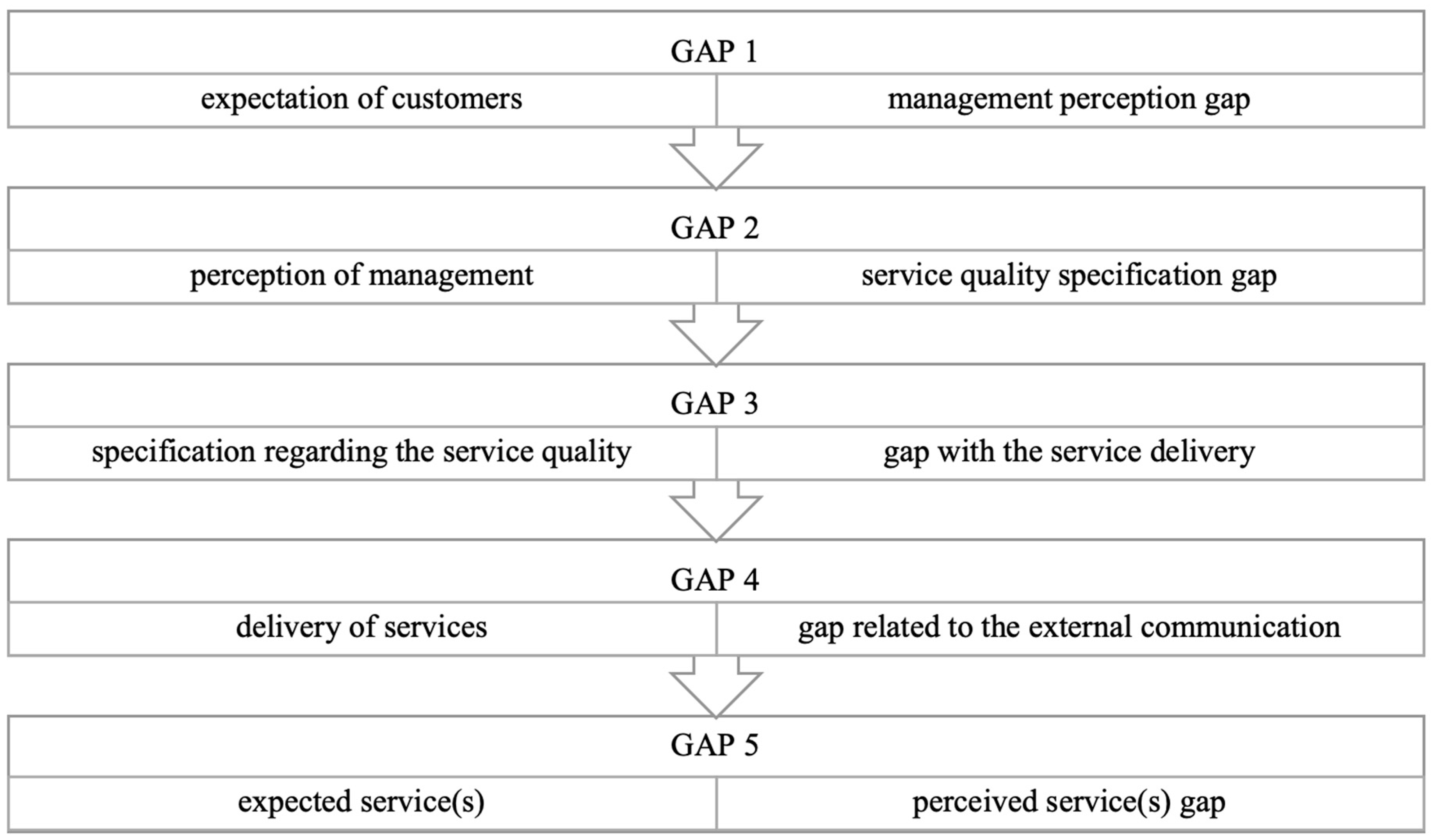
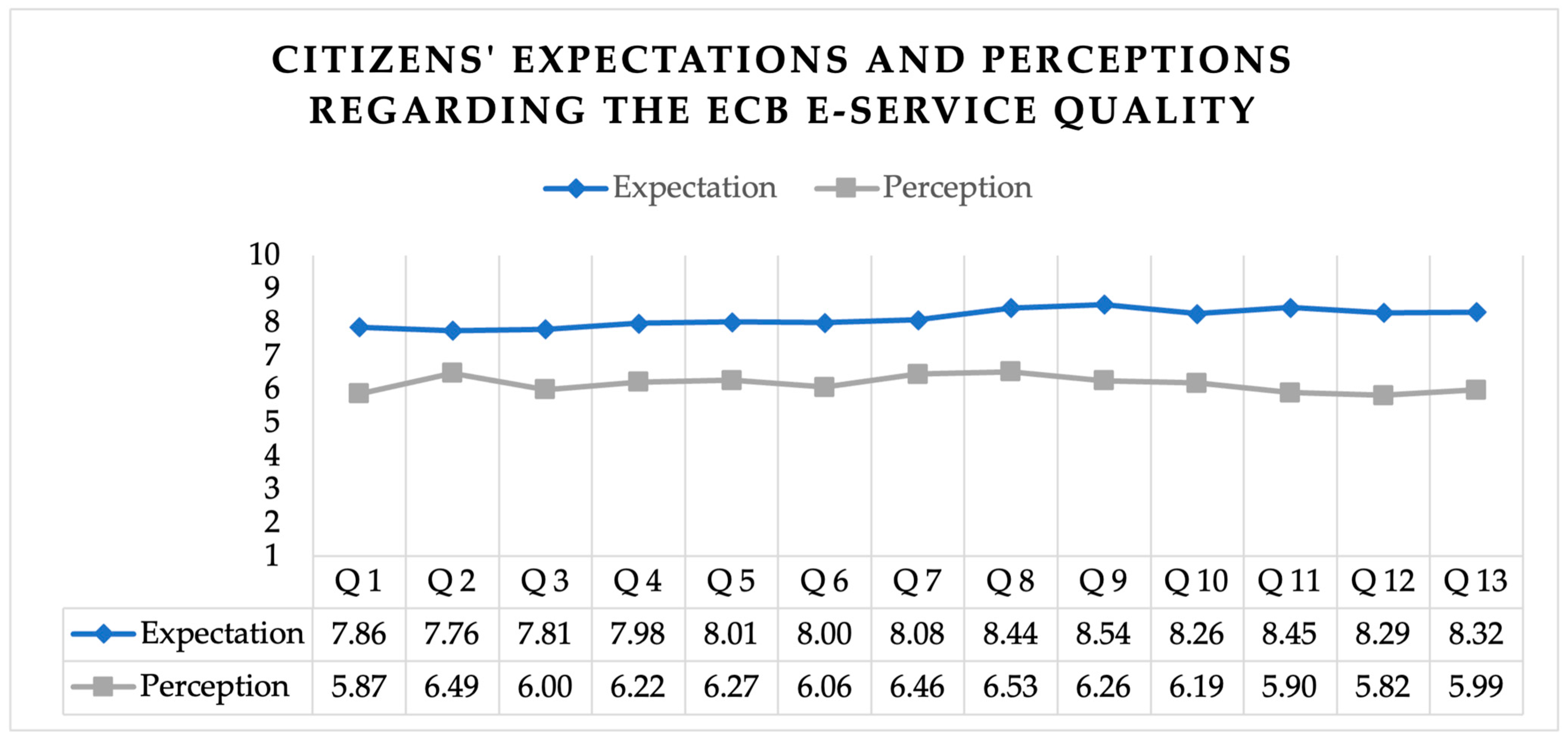
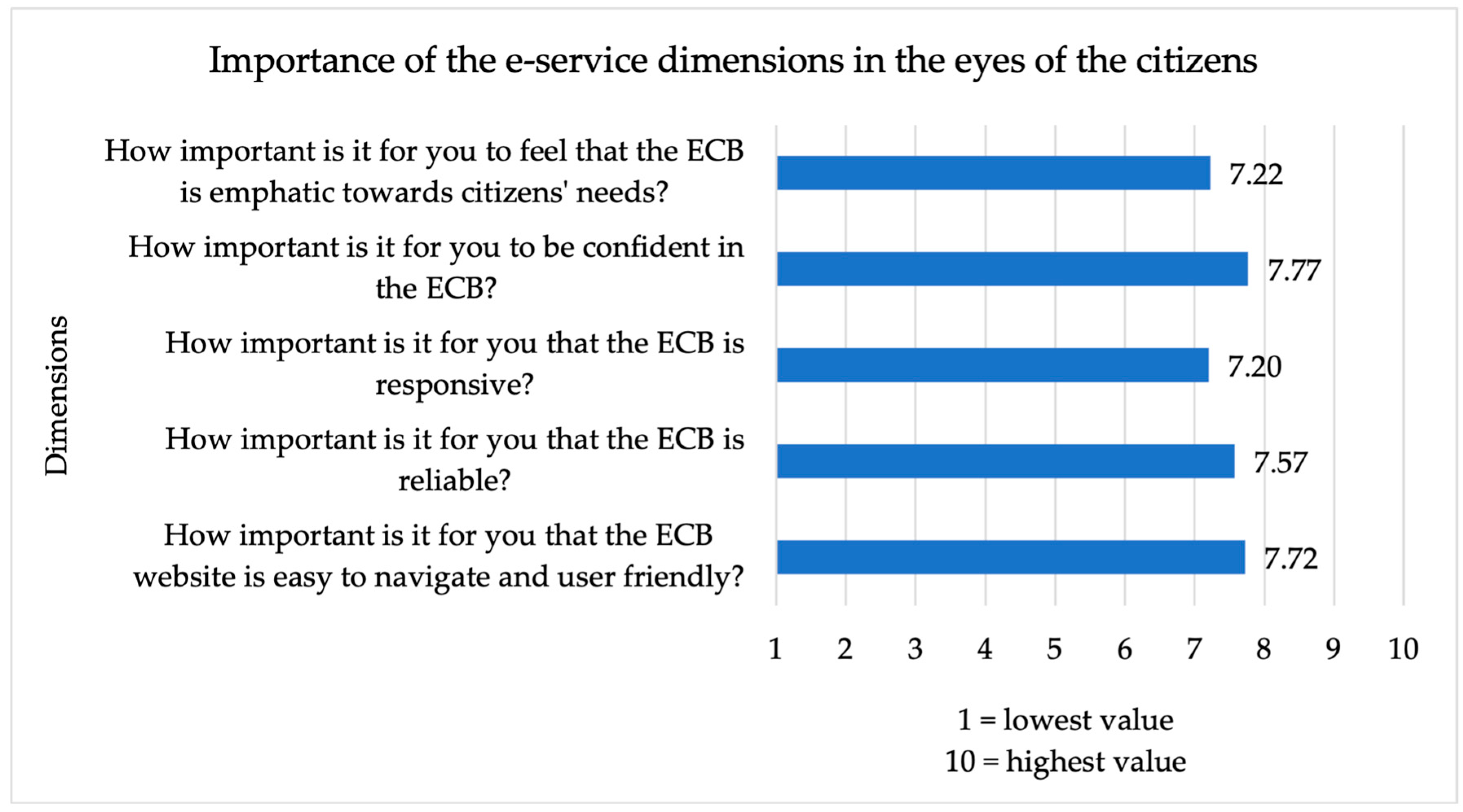
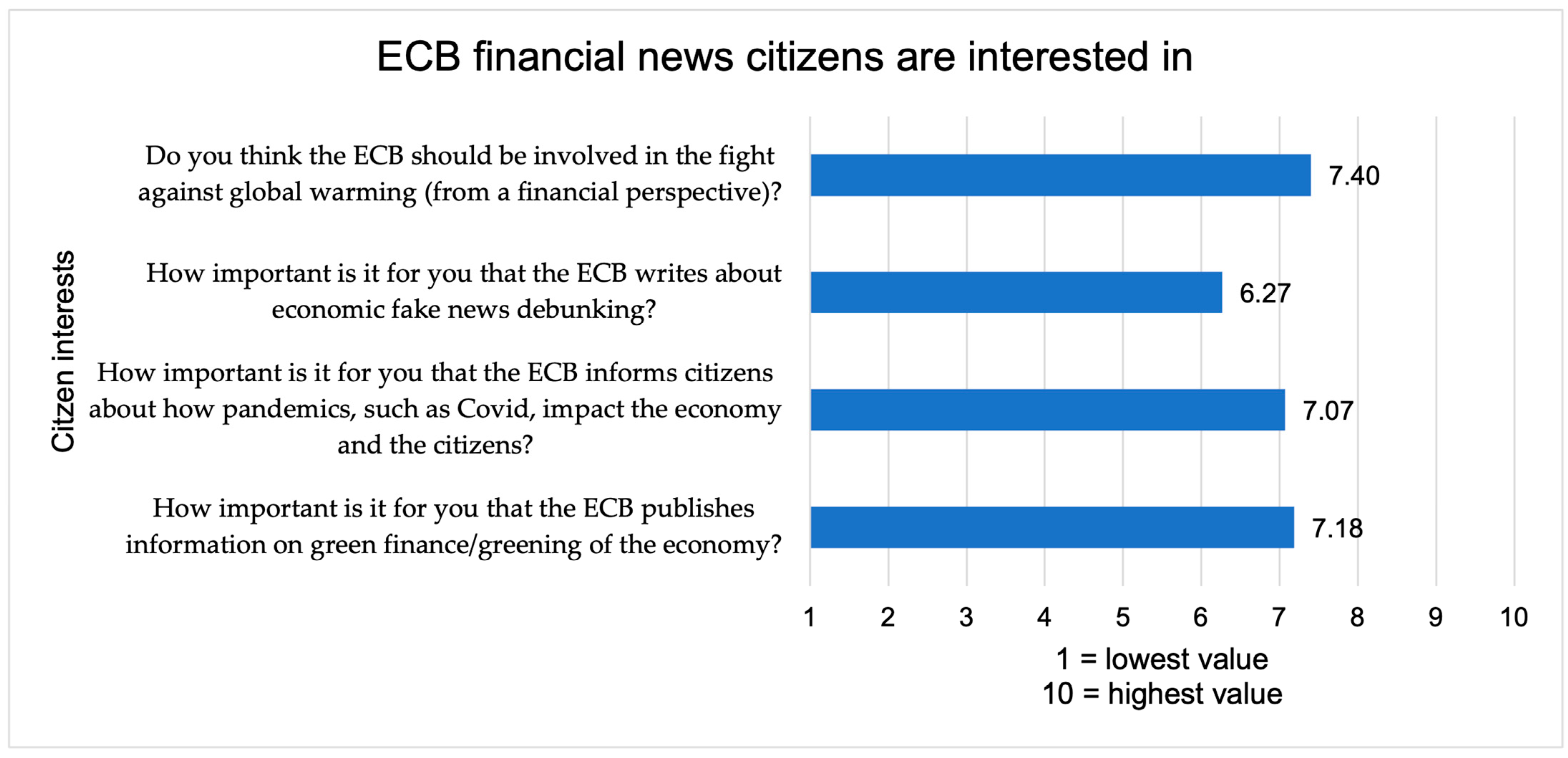
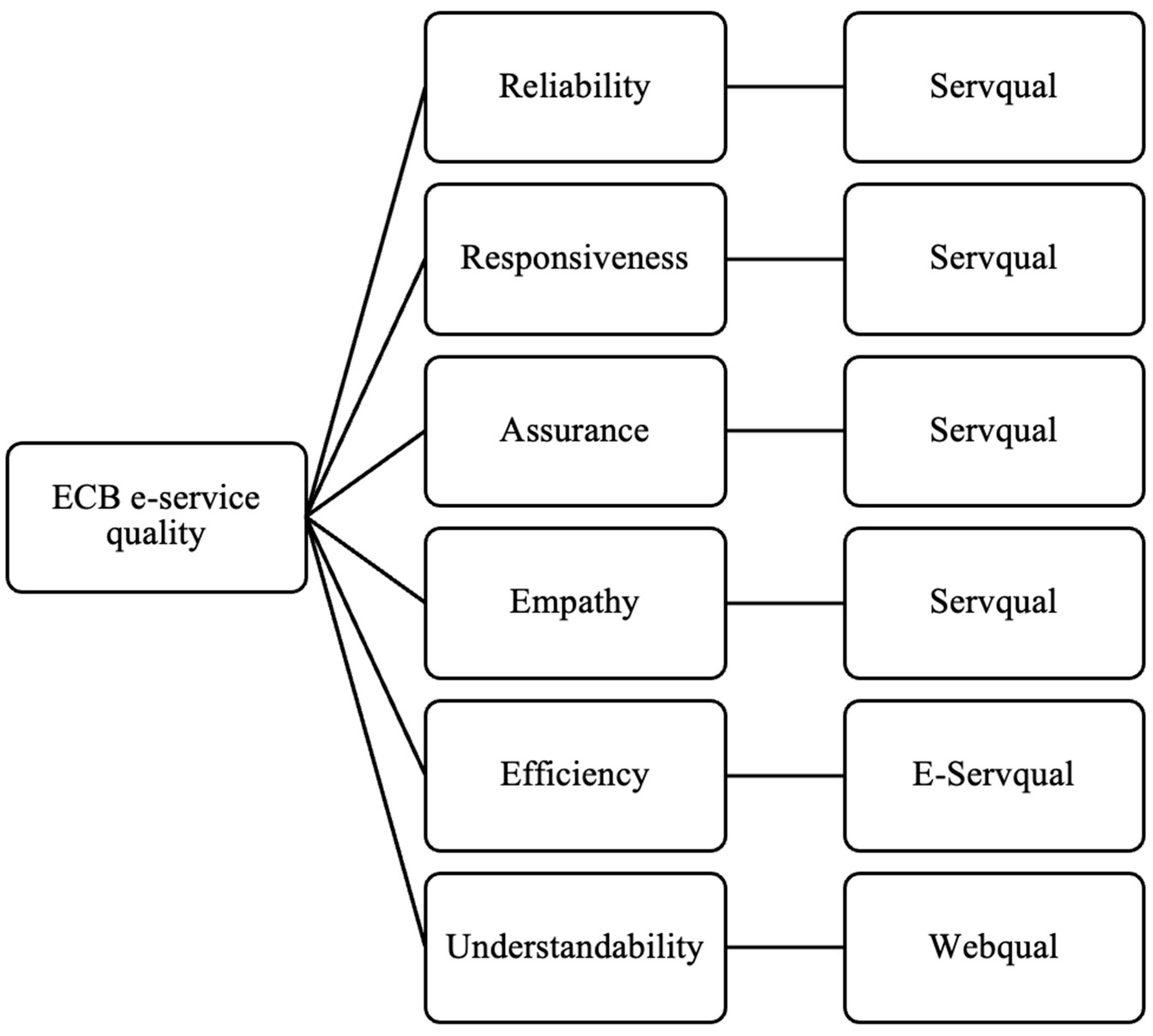
| Authors and Year | Context | Main Dimensions |
|---|---|---|
| (Dabholkar 1996) | E-Service | Reliability, ease of use, design, control, visitor entertainment |
| (Zeithaml et al. 2002) | E-Service | Website security and communication, reliability and responsiveness, delivery |
| (Madu and Madu 2002) | E-Service | Website performance and reliability, features, security and system integrity, responsiveness, service differentiation and customization, reputation, visitor assurance and trust, empathy |
| (Surjadaja et al. 2003) | E-Service | Website security and reliability, interactive features, presented information, customization options |
| (Santos 2003) | E-Service | Website appearance and structure, ease of use, efficiency and reliability, customer service, communication |
| (Field et al. 2004) | E-Service | Website security and reliability, design, customer service |
| (Yang and Fang 2004) | E-Service | Website responsiveness and reliability, information credibility, ease of access, website design |
| (Parasuraman et al. 2005) | E-Service | Website efficiency and availability, fulfilment of visitor needs, privacy features, responsiveness, contact options, and quality and compensation (if applicable) |
| (Fassnacht and Koese 2006) | E-Service | Graphical features and ease of use, technical capabilities, information layout, reliability, emotional and functional benefits |
| (Cristobal et al. 2007) | E-Service | Order management, customer service, website design and assurance |
| (Loiacono et al. 2007) | E-Service | Usability of the website, ease of use, entertainment, customer service, complementary relationship |
| (Sohn and Tadisina 2008) | Online financial services | Website functionality, content quality, trust, reliability, personalized communication, speed of delivery, ease of use |
| (Yuan and Ru 2011) | E-Service | Responsiveness, interface friendliness, accessibility |
| (Blut et al. 2015) | E-Service | Website design, privacy, customer service, fulfilment |
| (Hayo and Neuenkirch 2015) | E-Service | Responsiveness, reliability, system availability, customer service |
| (Ighomereho et al. 2022) | E-Service | Responsiveness, ease of use, reliability, website security, fulfilment |
| Question | Statement | GAP | Average Unweighted GAP Score for the Reliability Dimension |
|---|---|---|---|
| 1 | Reliability. Taking action on time | −1.99 | −1.69 |
| 2 | Reliability. Performing actions correctly | −1.27 | |
| 3 | Reliability. Showing a genuine interest in solving problems | −1.81 | |
| 4 | Responsiveness. Communicate about actions that impact citizens | −1.75 | −1.81 |
| 5 | Responsiveness. Being prompt in the performance of actions impacting citizens | −1.74 | |
| 6 | Responsiveness. Performing actions to help citizens | −1.94 | |
| 7 | Assurance. Creating confidence in citizens through behaviour and economic impact | −1.62 | −1.76 |
| 8 | Assurance. Citizens trust the actions taken | −1.91 | |
| 9 | Empathy. Performing actions with citizens’ best interests in mind | −2.28 | −2.17 |
| 10 | Empathy. Understanding the economic and ecologic needs | −2.07 | |
| 11 | Efficiency. Easy to find information on the website | −2.55 | −2.51 |
| 12 | Efficiency. Well-organized information on the website | −2.47 | |
| 13 | Understandability. Easy to navigate and user-friendly website | −2.33 | −2.33 |
| Criteria | Characteristic | Frequency | Percentage % |
|---|---|---|---|
| Gender | Female | 188 | 46 |
| Male | 218 | 54 | |
| Age | <20 years | 27 | 7 |
| 20–30 years | 82 | 20 | |
| 31–40 years | 108 | 27 | |
| 41–50 years | 26 | 6 | |
| 51–60 years | 82 | 20 | |
| >60 years | 81 | 20 | |
| Education level | High school | 61 | 15 |
| Bachelor’s degree | 190 | 47 | |
| Master’s degree | 126 | 31 | |
| Doctoral degree or higher | 29 | 7 |
Disclaimer/Publisher’s Note: The statements, opinions and data contained in all publications are solely those of the individual author(s) and contributor(s) and not of MDPI and/or the editor(s). MDPI and/or the editor(s) disclaim responsibility for any injury to people or property resulting from any ideas, methods, instructions or products referred to in the content. |
© 2023 by the authors. Licensee MDPI, Basel, Switzerland. This article is an open access article distributed under the terms and conditions of the Creative Commons Attribution (CC BY) license (https://creativecommons.org/licenses/by/4.0/).
Share and Cite
Prodan, S.; Dabija, D.-C. Adapting the Digital Servuction Model to Central Banks: Case Study: European Central Bank. Adm. Sci. 2023, 13, 217. https://doi.org/10.3390/admsci13100217
Prodan S, Dabija D-C. Adapting the Digital Servuction Model to Central Banks: Case Study: European Central Bank. Administrative Sciences. 2023; 13(10):217. https://doi.org/10.3390/admsci13100217
Chicago/Turabian StyleProdan, Silvana, and Dan-Cristian Dabija. 2023. "Adapting the Digital Servuction Model to Central Banks: Case Study: European Central Bank" Administrative Sciences 13, no. 10: 217. https://doi.org/10.3390/admsci13100217
APA StyleProdan, S., & Dabija, D.-C. (2023). Adapting the Digital Servuction Model to Central Banks: Case Study: European Central Bank. Administrative Sciences, 13(10), 217. https://doi.org/10.3390/admsci13100217






